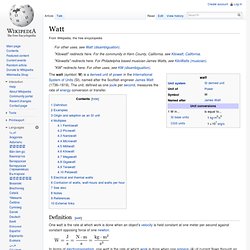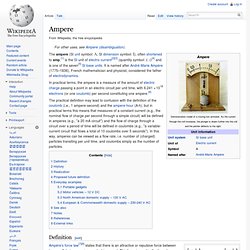

E20. Ammeter-clamps-18971-3466741. Watt. Definition[edit] In terms of electromagnetism, one watt is the rate at which work is done when one ampere (A) of current flows through an electrical potential difference of one volt (V).

Two additional unit conversions for watt can be found using the above equation and Ohm's Law. Where ohm ( ) is the SI derived unit of electrical resistance. Examples[edit] A person having a mass of 100 kilograms who climbs a 3-meter-high ladder in 5 seconds is doing work at a rate of about 600 watts. Origin and adoption as an SI unit[edit] The watt is named after the Scottish scientist James Watt for his contributions to the development of the steam engine.
Multiples[edit] Femtowatt[edit] The femtowatt is equal to one quadrillionth (10−15) of a watt. Picowatt[edit] The picowatt is equal to one trillionth (10−12) of a watt. Nanowatt[edit] The nanowatt is equal to one billionth (10−9) of a watt. Microwatt[edit] The microwatt is equal to one millionth (10−6) of a watt. Ohm's law. V, I, and R, the parameters of Ohm's law. where I is the current through the conductor in units of amperes, V is the potential difference measured across the conductor in units of volts, and R is the resistance of the conductor in units of ohms.

More specifically, Ohm's law states that the R in this relation is constant, independent of the current.[3] The law was named after the German physicist Georg Ohm, who, in a treatise published in 1827, described measurements of applied voltage and current through simple electrical circuits containing various lengths of wire. He presented a slightly more complex equation than the one above (see History section below) to explain his experimental results. The above equation is the modern form of Ohm's law. In physics, the term Ohm's law is also used to refer to various generalizations of the law originally formulated by Ohm. History. Ampere. In practical terms, the ampere is a measure of the amount of electric charge passing a point in an electric circuit per unit time, with 6.241×1018 electrons (or one coulomb) per second constituting one ampere.[6] The practical definition may lead to confusion with the definition of the coulomb (i.e., 1 ampere-second) and the ampere-hour (A·h), but in practical terms this means that measures of a constant current (e.g., the nominal flow of charge per second through a simple circuit) will be defined in amperes (e.g., "a 20 mA circuit") and the flow of charge through a circuit over a period of time will be defined in coulombs (e.g., "a variable-current circuit that flows a total of 10 coulombs over 5 seconds").

In this way, amperes can be viewed as a flow rate, i.e. number of (charged) particles transiting per unit time, and coulombs simply as the number of particles. Volt. Definition[edit] It can also be expressed as amps×ohms (Ohm's law), power per unit current (Joule's law), or energy per unit charge: Josephson junction definition[edit] Between 1990 and 1997, the volt was calibrated using the Josephson effect for exact voltage-to-frequency conversion, combined with cesium-133 time reference, as decided by the 18th General Conference on Weights and Measures.

The following value for the Josephson constant is used: K{J-90} = 2e/h = 0.4835979 GHz/µV, where e is the elementary charge and h is the Planck constant. Water flow analogy[edit] In the water flow analogy sometimes used to explain electric circuits by comparing them with water-filled pipes, voltage (difference in electric potential) is likened to difference in water pressure. The relationship between voltage and current is defined (in ohmic devices) by Ohm's Law.